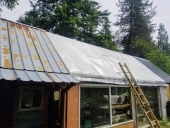


Trace Oswald wrote:No input on those products, but forums are notorious for not answering your question, and giving something else entirely, so here is my contribution. Consider tempered glass. Strong, great light transmission, and (although I know you said it isn't relevant), free. Most any glass company will give you tempered glass that was not used because it costs them more to send it back than they get for it. Tempered glass can't be cut, so if a piece was the wrong size or the customer didn't take it, it's no good to the company. I have a dozen or more sheets that are at least 4 feet wide and 8 feet long waiting for a greenhouse build. Just another avenue to consider.

thomas rubino wrote:Hi John; Just to confuse you more... Look up Solexx. Not the rigid panels but the roll.
I can't recommend it enough! Absolutely wonderful to work with and other than some discoloring it is still great in its tenth year.
Search around and you'll find they will ship the roll stuff free.

James Whitelaw wrote:We’ve been thinking of warming strategies for a planned greenhouse. My sense is with any greenhouse a lot of the heat collects at the top and is wasted. I’ve seen some Chinese designs where there is a secondary layer of plastic deployed above the plants to keep warmth closer to the ground. One strategy is to install low tunnels inside of high tunnels (examples can be seen in this PDF). Warming mats under trays of plants seems a direct, less wasteful method than heating the entire space. Heated water in tubes would be another strategy.
Sena Kassim wrote:John, I had no idea those formulas existed. I reviewed with my hubby. We are very impressed. Nice work. You get an apple.
Thanks to you and Skandi for taking this to a whole new place. I really enjoy being a part of this community.
Y'all rock. ⛰️

William Bronson wrote:I've only read about smooth pipe used in earth tubes, where they have had issues mold.
Swabbing the insides with rags or pouring cleaners down the holes are some of the remedies.
Theses pipes are not described as being perforated.
In climate batteries, tubing that is corrugated and perforated reportedly avoids mold due to the actions of soil organisms.
I imagine a perforated tube without corrugations are better against mold than ones with corragations.
Skandi Rogers wrote:Wow that took me a while to find, you've made a mistake on the German site, you used the 0.58 U-Value figure which is in imperial you need to convert that to metric the formula works for both metric and imperial but you cannot mix them. the 19kWh figure is correct.
Edit this post has been massacred by the "you cannot use abbreviation" software very hard to write formulas without them
for the bold imperial read British thermal unit per hour foot squared F and for the bold metric read Watts per meter squared Kelvin
 That would have been much cheaper to heat.
That would have been much cheaper to heat.